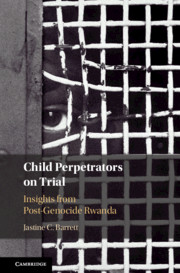Book contents
- Child Perpetrators on Trial
- Child Perpetrators on Trial
- Copyright page
- Epigraph
- Contents
- Foreword
- Preface and Acknowledgements
- Abbreviations
- 1 Introduction
- 2 International Standards on Child Perpetrators of Atrocities
- 3 Putting International Standards into Practice
- 4 Rwanda: Setting the Context
- 5 Rwanda’s Responses, in Law, Policy and Practice, to Child Génocidaires
- 6 International Actors and the Rwandan Child Génocidaire
- 7 UNICEF Rwanda’s Policy and Advocacy: A Strategic Approach
- 8 Evaluating UNICEF Rwanda’s Approach
- 9 Child Perpetrators and Child Rights: Rwanda and Beyond
- Book part
- Bibliography
- Index
4 - Rwanda: Setting the Context
Published online by Cambridge University Press: 18 October 2019
- Child Perpetrators on Trial
- Child Perpetrators on Trial
- Copyright page
- Epigraph
- Contents
- Foreword
- Preface and Acknowledgements
- Abbreviations
- 1 Introduction
- 2 International Standards on Child Perpetrators of Atrocities
- 3 Putting International Standards into Practice
- 4 Rwanda: Setting the Context
- 5 Rwanda’s Responses, in Law, Policy and Practice, to Child Génocidaires
- 6 International Actors and the Rwandan Child Génocidaire
- 7 UNICEF Rwanda’s Policy and Advocacy: A Strategic Approach
- 8 Evaluating UNICEF Rwanda’s Approach
- 9 Child Perpetrators and Child Rights: Rwanda and Beyond
- Book part
- Bibliography
- Index
Summary
Chapter 4 introduces the case study of Rwanda, which offers a paradigmatic example of what happens when thousands of minors are accused of, and pursued for, committing acts of atrocity, in a post-conflict state that has been thoroughly decimated. The chapter first provides a synopsis of the civil war and genocide, describing in particular children’s involvement as perpetrators. It then turns to post-genocide Rwanda to explore the impact of the genocide on the social fabric (in particular the perception of the child and society’s demand for justice and accountability) and the judicial system, and outlines the involvement of international and domestic actors in the reconstruction process. Finally, it briefly examines the position of the child offender under Rwandan law, noting also Rwanda’s international obligations at the time covered by the book. In addition to setting the scene, the chapter draws out the challenges generated primarily by the genocide (recognising that some issues were latent) so as to contextualise both Rwanda’s responses to child perpetrators as well as the approach adopted by international actors, in particular UNICEF.
Keywords
- Type
- Chapter
- Information
- Child Perpetrators on TrialInsights from Post-Genocide Rwanda, pp. 78 - 104Publisher: Cambridge University PressPrint publication year: 2019

